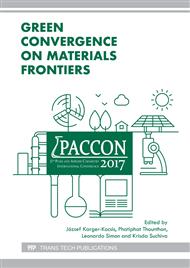[1]
S.A. Ashter, Introduction to bioplastics engineering, A volume in Plastics Design Library (2016) 19–30.
Google Scholar
[2]
O. Faruka, A.K. Bledzkia, H.P. Fink, M. Sain, Biocomposites reinforced with natural fibers: 2000–2010, Progress in Polymer Science 37 (2012) 1552– 1596.
DOI: 10.1016/j.progpolymsci.2012.04.003
Google Scholar
[3]
A.H. Hassanin, T. Hamouda, Z. Candan, A. Kilic, T. Akbulut, Developing high-performance hybrid green composites, Composites Part B (2016) 384-394.
DOI: 10.1016/j.compositesb.2016.02.051
Google Scholar
[4]
Z. Jin, G. Jin, S. Shao, K. S. Katsumata, Lignin characteristics of bast fiber and core in kenaf bark and wood of paper mulberry and mulberry, J Wood Sci (2012) 58: 144–152.
DOI: 10.1007/s10086-011-1228-4
Google Scholar
[5]
M. Jitjaicham,B. Kusuktham, Preparation of paper mulberry fibers and possibility of cotton/paper mulberry yarns production, Indian Journal of Materials Science (2016).
DOI: 10.1155/2016/1498967
Google Scholar
[6]
C. Aubertin, Paper Mulberry (Broussonetia papyrifera) in Lao PDR: a successful example of forest product domestication, Forest Products Livelihoods and Conservation 1 (2004) 227-245.
Google Scholar
[7]
T.R. Téllez, E.M.D. R López, G.L. Granado, E.A. Pérez, R.M. López and J.M. S Guzmán, The Water Hyacinth, Eichhornia crassipes: an invasive plant in the Guadiana River Basin (Spain), Aquatic Invasions (2008) Volume 3, Issue 1: 42-53.
DOI: 10.3391/ai.2008.3.1.8
Google Scholar
[8]
A. Malik, Environmental challenge vis a vis opportunity: The case of water hyacinth, Environment International 33 (2007) 122–138.
DOI: 10.1016/j.envint.2006.08.004
Google Scholar
[9]
H. Abral, D. Kadriadi, A. Rodianus, P. Mastariyanto, Ilhamdi, S. Arief, S.M. Sapuan, M.R. Ishak, Mechanical properties of water hyacinth fibers – polyester composites before and after immersion in water, Materials and Design 58 (2014) 125–129.
DOI: 10.1016/j.matdes.2014.01.043
Google Scholar
[10]
J. Mahujchariyawong, S. Ikeda, Modelling of environmental phytoremediation in eutrophic river the case of water hyacinth harvest in Tha-chin River, Thailand, Ecological Modelling 142 (2001) 121–134.
DOI: 10.1016/s0304-3800(01)00283-6
Google Scholar
[11]
H. Abral, H. Putra, S.M. Sapuan, M.R. Ishak, Effect of alkalization on mechanical properties of water hyacinth fibers-unsaturated polyester composites, polymer-Plastics technology and Engineering 52 (2013) 446–451.
DOI: 10.1080/03602559.2012.748804
Google Scholar
[12]
H. Ku, H. Wang, N. Pattarachaiyakoop, M. Trada, A review on the tensile properties of natural fiber reinforced polymer composites, Composites: Part B 42 (2011) 856–873.
DOI: 10.1016/j.compositesb.2011.01.010
Google Scholar
[13]
T. Gurunathan, S. Mohanty, S.K. Nayak, A review of the recent developments in biocomposites based on natural fibers and their application perspectives, Composites: Part A (2015) 1-25.
DOI: 10.1016/j.compositesa.2015.06.007
Google Scholar


